

Grevenburg was a castle in Traben-Trarbach in the federal state of Rhineland-Palatinate in Germany. It was the residence of the Rear County of Sponheim and today is a ruin following its destruction by the French in 1734.


Grevenburg was a castle in Traben-Trarbach in the federal state of Rhineland-Palatinate in Germany. It was the residence of the Rear County of Sponheim and today is a ruin following its destruction by the French in 1734.
The castle was built in 1350 by the Count Johann III of Sponheim-Starkenburg and replaced Castle Starkenburg as the residence of the Rear County of Sponheim. With the extinction of the ruling male line of the Rhenish branch of the House of Sponheim in 1437 the castle became seat of the bailiff of the new Counts to Sponheim (Baden and Palatinate-Simmern or Palatinate-Zweibrücken or Palatinate-Birkenfeld).
In 1680 it was conquered by Louis XIV of France and was extended, together with the fort of Mont Royal in the horshoe bend of the Mosel north of the town of Traben-Trarbach as a part of the fortifications. During the War of the Spanish Succession (1701–1714), in 1702 it was taken by the French under Tallard and in 1704 on the express orders of the commanding officer John Churchill, 1st Duke of Marlborough it was overpowered by Friedrich of Hesse-Kassel. The badly damaged castle was then occupied by the Dutch. In 1730 it was repaired by the Electorate of Trier for the defence of Koblenz and the Rhine river. In the War of the Polish Succession it was taken after three weeks' siege for the fourth and last time by the French who destroyed it in July 1734. [1] The castle was blown up, huge chunks of it have plunged into the valley beneath.
Of the castle, although only the western wall of the former keep remains, the foundations are largely intact [2]
Coordinates: 49°56′48″N7°06′56″E / 49.9466°N 7.1155°E
| Wikimedia Commons has media related to Grevenburg . |

The Moselle is a river that rises in the Vosges mountains and flows from western Germany through Luxembourg,and north-eastern France. It is a left bank tributary of the Rhine, which it joins at Koblenz. A small part of Belgium is in its basin as it includes the Sauer and the Our.
Palatine Zweibrücken, or the County Palatine of Zweibrücken, is a former state of the Holy Roman Empire. Its capital was Zweibrücken. Its reigning house, a branch of the Wittelsbach dynasty, was also the Royal House of Sweden from 1654 to 1720.

Traben-Trarbach on the Middle Moselle is a town in the Bernkastel-Wittlich district in Rhineland-Palatinate, Germany. It is the seat of the like-named Verbandsgemeinde and a state-recognized climatic spa (Luftkurort). The city lies in the so-called "Valley of Dawn".

Enkirch is an Ortsgemeinde – a municipality belonging to a Verbandsgemeinde, a kind of collective municipality – in the Bernkastel-Wittlich district in Rhineland-Palatinate, Germany.
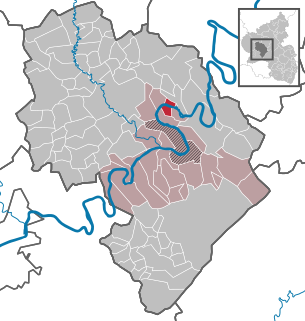
Erden is an Ortsgemeinde – a municipality belonging to a Verbandsgemeinde, a kind of collective municipality – in the Bernkastel-Wittlich district in Rhineland-Palatinate, Germany.

Irmenach is an Ortsgemeinde – a municipality belonging to a Verbandsgemeinde, a kind of collective municipality – in the Bernkastel-Wittlich district in Rhineland-Palatinate, Germany.

Lötzbeuren is an Ortsgemeinde – a municipality belonging to a Verbandsgemeinde, a kind of collective municipality – in the Bernkastel-Wittlich district in Rhineland-Palatinate, Germany.

Burg (Mosel) is an Ortsgemeinde – a municipality belonging to a Verbandsgemeinde, a kind of collective municipality – in the Bernkastel-Wittlich district in Rhineland-Palatinate, Germany. It is purely a winegrowing and tourism centre.
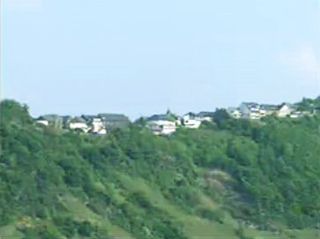
Starkenburg is an Ortsgemeinde – a municipality belonging to a Verbandsgemeinde, a kind of collective municipality – in the Bernkastel-Wittlich district in Rhineland-Palatinate, Germany. It is the location of the like-named castle, now in ruins.
Traben-Trarbach is a Verbandsgemeinde in the district Bernkastel-Wittlich, in Rhineland-Palatinate, Germany. Its seat of administration is in Traben-Trarbach. On 1 July 2014 it was expanded with the municipalities of the former Verbandsgemeinde Kröv-Bausendorf.

Dill is an Ortsgemeinde – a municipality belonging to a Verbandsgemeinde, a kind of collective municipality – in the Rhein-Hunsrück-Kreis (district) in Rhineland-Palatinate, Germany. It belongs to the Verbandsgemeinde of Kirchberg, whose seat is in the like-named town, and it is home to a castle ruin that bears the same name.
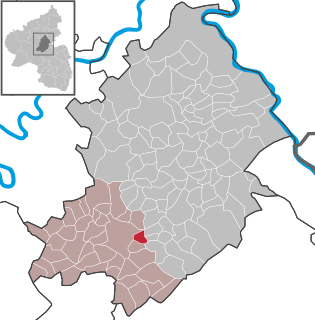
Rödern is an Ortsgemeinde – a municipality belonging to a Verbandsgemeinde, a kind of collective municipality – in the Rhein-Hunsrück-Kreis (district) in Rhineland-Palatinate, Germany. It belongs to the Verbandsgemeinde of Kirchberg, whose seat is in the town of Kirchberg.

The County of Sponheim was an independent territory in the Holy Roman Empire that lasted from the 11th century until the early 19th century. The name comes from the municipality of Sponheim, where the counts had their original residence.
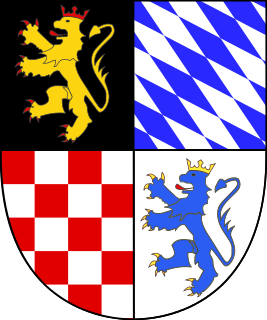
Palatinate-Birkenfeld, later Palatinate-Zweibrücken-Birkenfeld, was the name of a collateral line of the Palatine Wittelsbachs. The Counts Palatine from this line initially ruled over only a relatively unimportant territory, namely the Palatine share of the Rear County of Sponheim; however, their importance steadily grew. All living members of the House of Wittelsbach descend from Palatinate-Birkenfeld, which thus became the parent branch of the Kings of Bavaria.
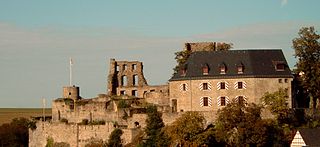
Kastellaun Castle is a ruined medieval castle in Kastellaun in the Rhein-Hunsrück district in Rhineland-Palatinate, Germany.
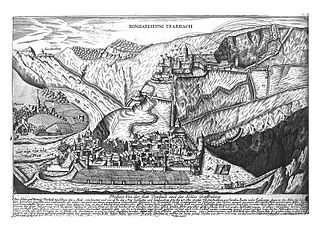
The Siege of Trarbach was conducted during the War of the Polish Succession by French troops against a garrison of troops of the Holy Roman Empire in the fortress at Trarbach in the County of Sponheim, a small principality of the Holy Roman Empire. The French, led by Marshal Belle-Isle, were victorious, and destroyed the fortress.

Johann III, Count of Sponheim-Starkenburg, the Older, reigned over the County of Sponheim for 67 years. He also received many epithets such as "the Noble" and, because of his declining vision, "the Blind".

Gutenburg Castle, is the ruin of a hill castle above the village of Gutenberg in the county of Bad Kreuznach in the German state of Rhineland-Palatinate.